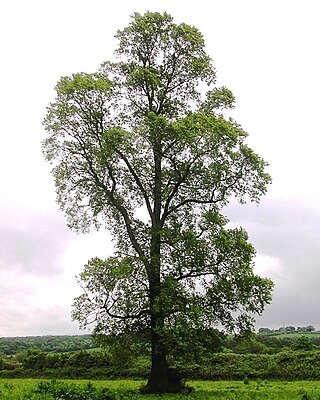
Elms are deciduous and semi-deciduous trees comprising the genus Ulmus in the family Ulmaceae. They are distributed over most of the Northern Hemisphere, inhabiting the temperate and tropical-montane regions of North America and Eurasia, presently ranging southward in the Middle East to Lebanon and Israel, and across the Equator in the Far East into Indonesia.
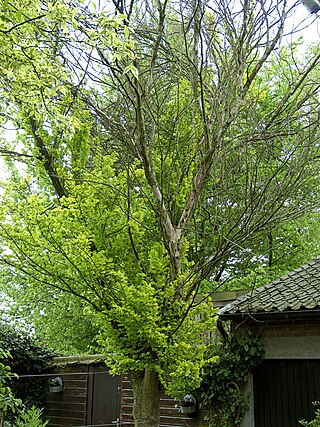
Dutch elm disease (DED) is caused by a member of the sac fungi (Ascomycota) affecting elm trees, and is spread by elm bark beetles. Believed to be originally native to Asia, the disease was accidentally introduced into America, Europe, and New Zealand. In these regions it has devastated native populations of elms that did not have resistance to the disease. The name "Dutch elm disease" refers to its identification in 1921 and later in the Netherlands by Dutch phytopathologists Bea Schwarz and Christine Buisman, who both worked with professor Johanna Westerdijk. The disease affects species in the genera Ulmus and Zelkova, therefore it is not specific to the Dutch elm hybrid.
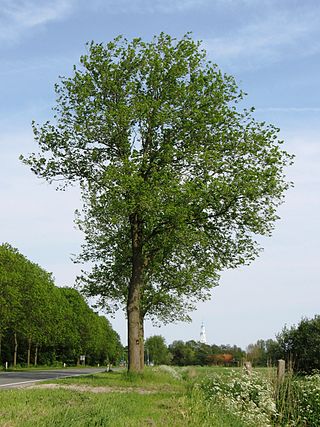
Ulmus × hollandica 'Commelin' is a Dutch hybrid cultivar released for sale in 1960. The tree was raised at Baarn as clone 274 by the Foundation Willie Commelin Scholten Phytopathological Laboratory in 1940, from a crossing of Ulmus × hollandica 'Vegeta' and clone 1, an Ulmus minor selected from a 1929 elm seedlings lot obtained from the Barbier nursery, Orléans.

Ulmus 'Lobel' is a Dutch hybrid cultivar raised at the Dorschkamp Research Institute for Forestry & Landscape Planning, Wageningen, from a crossing of clone '202' with '336'. 'Lobel' was cloned in 1962 and released for sale in 1973.

The Field Elm cultivar Ulmus minor 'Christine Buisman' was the first cultivar released by the Dutch elm breeding programme, initiated in response to the less virulent form of Dutch elm disease (DED), Ophiostoma ulmi, which afflicted Europe's elms after the First World War. 'Christine Buisman' was selected from a batch of 390 seedlings grown from seed collected in the Parque de la Quinta de la Fuente del Berro, Madrid, by Mrs Van Eeghen, a friend of elm researcher Johanna Westerdijk, in 1929 and named for the elm disease researcher Christine Buisman. Originally identified as Ulmus foliacea, it was later treated as Ulmus × hollandica by Melville. However, more recent research in Belgium using DNA markers has reaffirmed 'Christine Buisman' as a clone of U. minor.
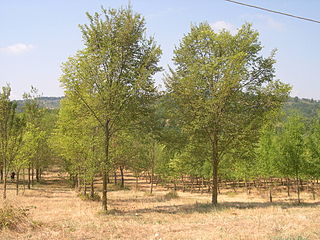
Ulmus 'Arno' is an Italian hybrid cultivar derived from a crossing of 'Plantyn' with the Siberian Elm Ulmus pumila clone S.2. It was raised by the Istituto per la Protezione delle Piante (IPP) in Florence, and released in 2007. However, 'Arno' was not a commercial success; propagation had ceased by 2010, and it is no longer patent protected.

Ophiostoma ulmi is a species of fungus in the family Ophiostomataceae. It is one of the causative agents of Dutch elm disease. It was first described under the name Graphium ulmi, and later transferred to the genus Ophiostoma.
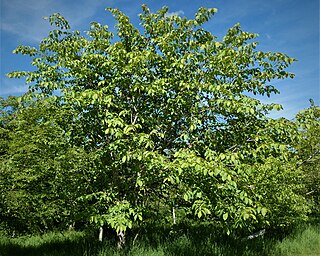
The elm Ulmus wallichiana subsp. xanthoderma was identified by Melville and Heybroek after the latter's expedition to the Himalaya in 1960. The tree is of more western distribution than subsp. wallichiana, ranging from Afghanistan to Kashmir.
Ulmus wallichiana subsp. wallichiana was identified by Melville and Heybroek after the latter's expedition to the Himalaya in 1960.
Ulmus wallichiana var. tomentosa was identified by Melville & Heybroek after the latter's expedition to the Himalaya in 1960.

Rhytisma is a genus of fungi in the Rhytismataceae family commonly known as 'tar spot'. There are about 18 species, which live parasitically in the leaves of deciduous trees.

Professor Eugene Byron Smalley (1926–2002) was an American plant pathologist. Smalley joined the University of Wisconsin-Madison in 1957 with the specific aim of finding a way to control Dutch elm disease Assembling seeds from around the northern hemisphere, Smalley developed resistant strains of elms which were patented and released to commerce, notably 'Sapporo Autumn Gold', and 'New Horizon'.

Christine Johanna Buisman was a Dutch phytopathologist who dedicated her short career to the research of Dutch elm disease and the selection of resistant elm seedlings. In 1927, Buisman provided the final proof that Graphium ulmi was the causal agent of the disease, concluding the controversy which had raged among Dutch and German scientists since 1922.
Ophiostoma himal-ulmi is a species of fungus in the family Ophiostomataceae. It is one of the causative agents of Dutch elm disease. It was first isolated around breeding galleries of scolytid beetles in the bark of Ulmus wallichiana. This, together with the fact that it is endemic to the Himalayas, is the reason it is named himal-ulmi.

The Field Elm cultivar Ulmus minor 'Dehesa de la Villa' was cloned by root cuttings from a tree growing in the eponymous park within the Moncloa-Aravaca district of north-west Madrid, by researchers at the Escuela Técnica Superior de Ingenieros de Montes, Universidad Politėcnica de Madrid in 1990.

The Field Elm cultivar Ulmus minor 'Retiro' was raised from seed collected in 2002 from a tree growing in the El Retiro park, in the centre of Madrid by researchers at the Escuela Técnica Superior de Ingenieros de Montes, Universidad Politėcnica de Madrid.

The elm cultivar Ulmus 'Toledo' was raised from seed collected in 1999 from a tree believed to be Ulmus minor growing in the eponymous city, by researchers at the Escuela Técnica Superior de Ingenieros de Montes, Universidad Politėcnica de Madrid. However, retrospective DNA analysis revealed that the clone also had Ulmus pumila DNA, the species introduced to Spain at the end of the 16th century, and has consequently been dropped from the research programme.

Scolytus schevyrewi, the banded elm bark beetle, is a 3–4 mm long elm bark beetle species in the genus Scolytus native from Asia and accidentally introduced to North America. It is a vector of the Dutch elm disease, caused by the Ascomycota Ophiostoma ulmi and Ophiostoma novo-ulmi. In North America, it is displacing both the native elm bark beetle and the previously introduced smaller European elm bark beetle, which are becoming less common in their range with the expansion of S. schevyrewi.

Tetraneura ulmi, the elm sack gall aphid and also known as a fig gall, is a species of aphid in the family Aphididae. It was described by Carl Linnaeus and named in his Systema Naturae, published in 1758. The mite is found in Asia, Europe and North America, causing abnormal plant growths, known as galls on their primary host, elm trees (Ulmus species). They feed on a secondary host, the roots of various grasses.

Eriosoma ulmi, the elm-currant aphid, is a species of aphid in the family Aphididae found in Asia and Europe. It is a true bug and sucks sap from plants. It was described by Carl Linnaeus in his Systema Naturae, published in 1758. The mite causes abnormal plant growths, known as galls on their primary host, elm trees (Ulmus species). To complete there life-cycle they feed on a secondary host, the roots of currant bushes.

















